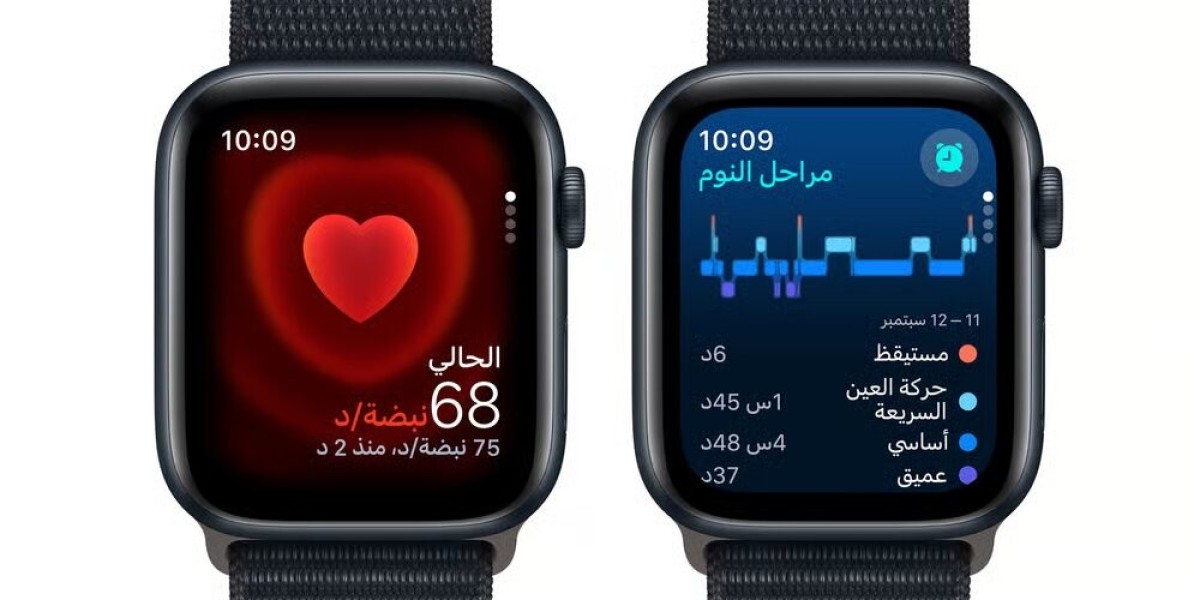Introduction
In an era where technology seamlessly integrates with our daily lives, the Apple Watch stands out as a powerful tool for enhancing health and wellness. Initially designed as a stylish accessory, the Apple Watch has evolved into a comprehensive health companion, offering a suite of features that help users monitor and improve their well-being. Whether you’re aiming to keep track of your heart health, optimize your workouts, or manage stress, the Apple Watch provides valuable insights and actionable data right on your wrist. In this guide, we’ll explore the key health and wellness features of the Apple Watch that you should be using to make the most of its capabilities and achieve a healthier, more balanced lifestyle.
Heart Rate Monitoring
The Apple Watch’s heart rate monitoring feature is designed to provide continuous, real-time insights into your heart rate throughout the day. Using advanced sensors located on the underside of the watch, it measures your heartbeats per minute (BPM) during various activities and at rest. This feature is particularly valuable for both fitness enthusiasts and those managing heart health.
Benefits
Stress Management: By monitoring your heart rate, you can gain insights into how stress affects your body. Elevated heart rates during periods of rest or sleep may indicate high stress levels, helping you take steps to manage it.
Workout Optimization: Tracking your heart rate during exercise allows you to stay within your target heart rate zone, ensuring that you’re working out effectively and safely. This helps maximize the benefits of your workouts, whether you’re aiming for endurance, fat burning, or cardiovascular health.
Health Alerts: The Apple Watch can notify you if your heart rate is unusually high or low, even when you’re at rest. This can be an early warning system for potential health issues, prompting you to seek medical advice if necessary.
Fitness Goals: Regular heart rate tracking helps in setting and achieving fitness goals. By understanding your heart rate trends, you can adjust your exercise routines to better align with your fitness objectives.
Usage Tips
Set Up Heart Rate Notifications: In the Apple Watch app on your iPhone, you can enable notifications for high and low heart rates. Customize these settings based on your health needs and preferences.
Check Your Heart Rate: You can view your current heart rate directly from the watch’s home screen or the Heart Rate app. Regularly checking this data can provide insights into your overall heart health.
Review Heart Rate Data: The Health app on your iPhone syncs with your Apple Watch to provide detailed heart rate data and trends. Review this information to track changes over time and understand your heart health better.
Optimize Your Workouts: Use the Workout app to monitor your heart rate during exercise. Choose specific workout modes that align with your fitness goals, such as running or cycling, to ensure accurate heart rate tracking.
By integrating heart rate monitoring into your daily routine, the Apple Watch becomes a valuable tool for maintaining and improving your overall health and fitness.
ECG (Electrocardiogram) Function
The Apple Watch’s ECG function is a sophisticated feature that allows you to record an electrocardiogram directly from your wrist. This feature, available on Apple Watch Series 4 and later models, uses electrical sensors to measure the electrical activity of your heart. It generates a detailed ECG that can help detect irregular heart rhythms, such as atrial fibrillation (AFib), which is a serious heart condition that can increase the risk of stroke.
Benefits
Early Detection of Heart Conditions: The ECG function can help detect AFib, a common type of irregular heartbeat that often goes unnoticed. Early detection allows for timely medical intervention, potentially preventing more serious health issues.
Peace of Mind: Regular ECG monitoring can provide reassurance about your heart health, especially if you have a history of heart problems or are at higher risk for heart disease.
Detailed Health Insights: The ECG app provides detailed information about your heart’s rhythm and electrical activity, giving you and your healthcare provider valuable data to assess your heart health more comprehensively.
Seamless Integration: The ECG data is seamlessly integrated into the Health app on your iPhone, making it easy to share with your healthcare provider and track over time.
Usage Tips
Performing an ECG: To take an ECG, open the ECG app on your Apple Watch and follow the on-screen instructions. You’ll need to keep your arm still and rest your finger on the Digital Crown for about 30 seconds to complete the recording.
Interpreting Results: Once the ECG is complete, the app will classify the result as either “Sinus Rhythm” (normal) or “AFib” (irregular). If the result is inconclusive, it will indicate “Inconclusive.” For any irregular results, consult with your healthcare provider for further evaluation.
Review and Share Data: The ECG data is saved in the Health app, where you can review your heart’s electrical activity over time. You can also export a PDF of the ECG report and share it with your healthcare provider for more detailed analysis.
Stay Informed: Regularly check the ECG app and review the data, especially if you experience symptoms such as palpitations or irregular heartbeats. Use this information to discuss your heart health with your doctor.
By incorporating the ECG function into your health routine, the Apple Watch provides a powerful tool for monitoring your heart’s electrical activity, offering valuable insights and early warnings that can enhance your overall cardiovascular health.
Blood Oxygen Monitoring
The blood oxygen monitoring feature on the Apple Watch, available on Series 6 and later, measures the percentage of oxygen in your blood. This is done using infrared sensors that shine light through your skin to assess how much oxygen is being carried by your red blood cells. The data is then used to provide insights into your respiratory and overall health.
Benefits
Assess Respiratory Health: Monitoring blood oxygen levels can help detect respiratory issues and conditions such as sleep apnea or chronic obstructive pulmonary disease (COPD). Abnormal oxygen levels may indicate a need for medical evaluation.
Improve Fitness Performance: By tracking your blood oxygen levels during exercise, you can gauge how well your body is utilizing oxygen and adjust your workouts for optimal performance and endurance.
Altitude Adaptation: For those living at high altitudes or traveling to elevated areas, monitoring blood oxygen levels can help manage and understand how your body is adjusting to lower oxygen environments.
Overall Health Insights: Regular tracking of blood oxygen levels can provide a broader understanding of your general health and help in identifying potential issues before they become serious.
Usage Tips
Measuring Blood Oxygen Levels: To measure your blood oxygen levels, open the Blood Oxygen app on your Apple Watch. Ensure that the watch is snug on your wrist and that you are still for 15-30 seconds during the measurement.
Reviewing Results: The app will display your blood oxygen level as a percentage. Normal levels typically range from 95% to 100%. If your readings consistently fall outside this range, consult with a healthcare provider for further evaluation.
Integrating Data: The data collected from the Blood Oxygen app is saved in the Health app on your iPhone. Use this data to track changes over time and to discuss any concerns with your doctor.
Daily Monitoring: Incorporate blood oxygen level checks into your daily routine, especially if you have respiratory conditions or are undergoing physical exertion. Regular monitoring can help you stay informed about your health status.
By utilizing the blood oxygen monitoring feature, the Apple Watch provides valuable insights into your respiratory health and overall well-being. Keeping track of your oxygen levels can help you make informed decisions about your health and fitness, offering a proactive approach to maintaining a healthy lifestyle.
Sleep Tracking
The sleep tracking feature on the Apple Watch, available from Series 3 onwards, helps you monitor your sleep patterns and improve sleep quality. The watch uses its sensors to track your sleep duration and quality, providing insights into your nightly rest. It also integrates with the Sleep app to help you establish and maintain a consistent sleep schedule.
Benefits
Improved Sleep Quality: By tracking your sleep, you can identify patterns and habits that affect your rest. This awareness allows you to make changes to improve the quality of your sleep.
Establishing Healthy Sleep Habits: The Apple Watch’s sleep tracking can help you set and stick to a regular sleep schedule, which is crucial for overall health and well-being.
Understanding Sleep Patterns: The data collected provides insights into how much time you spend in different sleep stages, such as REM, deep, and light sleep. Understanding these patterns can help you address any issues impacting your sleep.
Identifying Sleep Issues: Regular tracking can help identify potential sleep disorders or irregularities. If you notice persistent issues, you can seek professional help for further evaluation.
Usage Tips
Setting Up Sleep Tracking: Open the Sleep app on your Apple Watch or iPhone to set your sleep goals and bedtime. You can customize your sleep schedule and set up wind-down reminders to prepare for bed.
Wearing the Watch: Ensure that the Apple Watch is worn snugly but comfortably on your wrist while you sleep. Accurate tracking requires the watch to be in close contact with your skin.
Reviewing Sleep Data: After waking up, open the Sleep app on your iPhone to review your sleep metrics. The app provides information on how long you slept, the quality of your sleep, and your sleep trends over time.
Making Adjustments: Use the insights from your sleep data to make adjustments to your sleep environment and routine. For instance, you might adjust your bedtime, create a more relaxing pre-sleep routine, or address factors that disrupt your sleep.
Syncing with Health App: The sleep data is also synced with the Health app on your iPhone, where you can view comprehensive sleep trends and patterns. Use this information to track your progress and make informed decisions about your sleep health.
By leveraging the Apple Watch’s sleep tracking feature, you gain valuable insights into your sleep patterns, enabling you to make adjustments that enhance your overall sleep quality and contribute to better health and well-being.
Activity and Fitness Tracking
The Apple Watch’s activity and fitness tracking features provide a comprehensive overview of your physical activity throughout the day. The watch uses built-in sensors to monitor various aspects of your fitness, including movement, exercise, and standing periods. It tracks daily activity through three rings: Move, Exercise, and Stand, and offers a range of workout modes to suit different types of exercise.
Benefits
Motivation and Accountability: The three rings system (Move, Exercise, Stand) encourages you to stay active throughout the day by providing visual goals and reminders. Completing these rings each day can motivate you to maintain a healthy lifestyle.
Personalized Fitness Insights: The watch tracks your workouts and physical activity, providing detailed insights into calories burned, workout duration, and heart rate. This information helps you tailor your fitness routine to meet your goals.
Goal Setting and Achievement: Set personalized fitness goals and monitor your progress. The Apple Watch provides feedback and achievements as you reach milestones, helping you stay motivated and track your improvements.
Health Monitoring: Continuous tracking of activity and workouts helps you monitor your overall health, including cardiovascular fitness, calorie expenditure, and physical endurance.
Usage Tips
Set Up Activity Goals: Open the Activity app on your Apple Watch or iPhone to set your daily Move, Exercise, and Stand goals. Customize these goals based on your fitness level and objectives.
Track Workouts: Use the Workout app to start and track specific exercise sessions, such as running, cycling, swimming, or yoga. The watch provides real-time metrics, including duration, distance, pace, and heart rate, tailored to each workout type.
Monitor Activity Progress: Regularly check the Activity app to view your daily progress and see how close you are to closing your rings. The app also provides summaries of your weekly and monthly activity trends.
Explore Fitness Features: Take advantage of additional features, such as tracking your workouts with GPS, monitoring your heart rate zones, and using the built-in cadence and pace metrics for running or cycling.
Review Health Metrics: Sync your activity data with the Health app on your iPhone for a more comprehensive view of your fitness and health metrics. This integration allows you to track long-term trends and analyze your progress over time.
Stay Active with Reminders: Enable activity reminders to encourage regular movement throughout the day. The watch will alert you to stand, move, or exercise if you’ve been inactive for too long.
By utilizing the Apple Watch’s activity and fitness tracking features, you can gain valuable insights into your physical health, stay motivated, and make informed decisions to enhance your overall fitness and well-being.
Mindfulness and Breathing Exercises
The Apple Watch includes built-in mindfulness and breathing exercise features designed to help you manage stress and improve mental well-being. The Mindfulness app offers guided breathing exercises and meditation practices, while the Breathe app focuses on helping you practice deep breathing techniques. Both features are integrated into the watch to encourage regular mindfulness and relaxation practices.
Benefits
Stress Reduction: Regular use of mindfulness and breathing exercises can help lower stress levels by promoting relaxation and calming the mind. These practices are effective in managing daily stress and improving emotional health.
Enhanced Focus: Mindfulness exercises can improve your ability to focus and concentrate by training you to be present in the moment. This can lead to better performance in daily tasks and activities.
Better Sleep: Incorporating mindfulness and breathing exercises into your routine can help improve sleep quality by reducing anxiety and promoting relaxation before bedtime.
Emotional Well-being: Regular mindfulness practice can contribute to overall emotional well-being, helping you develop a more positive outlook and better manage emotional responses.
Usage Tips
Using the Breathe App: Open the Breathe app on your Apple Watch to start a breathing session. You can choose from different session lengths (e.g., 1, 3, or 5 minutes) and follow the on-screen instructions to focus on deep, steady breaths. The app provides gentle prompts to guide your breathing and helps you stay engaged in the exercise.
Engaging with the Mindfulness App: Access the Mindfulness app to explore a variety of guided practices, including meditation and reflection exercises. The app offers different themes and durations to suit your needs, whether you’re looking for a quick mental break or a more extended mindfulness session.
Set Reminders: Enable mindfulness reminders in the Apple Watch app on your iPhone to receive notifications throughout the day, prompting you to take a few moments for mindfulness or breathing exercises.
Integrate into Daily Routine: Incorporate mindfulness and breathing exercises into your daily routine by scheduling specific times for these practices. Consider using them during breaks, before or after meals, or as part of your bedtime routine.
Track Your Progress: The Mindfulness and Breathe apps track your usage and progress over time. Review this data to understand how frequently you engage in these practices and the impact on your overall well-being.
Customize Notifications: Adjust the notification settings for mindfulness and breathing exercises to suit your preferences. You can choose the frequency and timing of reminders to ensure they fit seamlessly into your daily life.
By incorporating mindfulness and breathing exercises into your routine with the Apple Watch, you can effectively manage stress, enhance focus, and improve your overall emotional and mental well-being. These tools offer a convenient way to prioritize self-care and cultivate a more balanced, mindful lifestyle.
Medication Tracking
The Apple Watch's medication tracking feature, available through the Health app on iPhone and Apple Watch, helps you manage and adhere to your medication regimen. This feature allows you to set reminders for taking your medications, track when you’ve taken them, and maintain a log of your medication history. It is designed to support individuals in managing their prescriptions and over-the-counter medications efficiently.
Benefits
Improved Adherence: Regular reminders help ensure you take your medications on time, reducing the risk of missed doses and improving overall adherence to your prescribed treatment.
Organized Tracking: Keeping a log of your medication intake helps you and your healthcare provider monitor your medication schedule, track usage, and make informed decisions about your treatment.
Convenient Reminders: The Apple Watch sends notifications to remind you to take your medication, making it easier to stay on track without having to rely on memory alone.
Health Monitoring: Tracking your medication intake provides valuable data that can be shared with your healthcare provider, helping them understand how well you’re following your medication plan and addressing any issues.
Usage Tips
Set Up Medication Tracking: Open the Health app on your iPhone and navigate to the Medication section. Add your medications by entering details such as the name, dosage, frequency, and any specific instructions.
Create Medication Reminders: Customize reminders for each medication by specifying the time of day and frequency for notifications. Ensure that these reminders are set up to alert you on your Apple Watch for timely notifications.
Track Medication Intake: After taking your medication, mark it as taken in the Health app or directly on your Apple Watch. This helps keep an accurate record of your adherence and provides a clear history of your medication intake.
Review Medication Logs: Regularly review your medication logs in the Health app to track your adherence and identify any patterns or issues. This data can also be shared with your healthcare provider during appointments.
Adjust Reminders as Needed: Update your medication reminders if there are changes to your medication schedule or if you need additional notifications. This ensures that your reminders stay relevant and effective.
Consult with Your Healthcare Provider: If you encounter any issues with medication tracking or have questions about your medication regimen, consult with your healthcare provider for guidance and support.
By utilizing the Apple Watch’s medication tracking feature, you can effectively manage your medication schedule, improve adherence, and ensure that you stay on top of your health and wellness goals. This feature offers a practical solution for maintaining an organized and consistent medication routine.
Fall Detection and Emergency SOS
The Apple Watch includes Fall Detection and Emergency SOS features designed to enhance safety and provide assistance in emergency situations. Fall Detection can identify hard falls and automatically contact emergency services if you are unresponsive, while Emergency SOS allows you to quickly call for help and notify your emergency contacts.
Fall Detection
Benefits
Immediate Help: If a hard fall is detected and you are unresponsive, the Apple Watch automatically contacts emergency services and sends your location to them. This feature is particularly useful for individuals at higher risk of falls, such as the elderly or those with medical conditions.
Automatic Alerts: If the watch detects a fall, it will vibrate and display an alert. If you do not respond within a specific timeframe, the watch will initiate a call to emergency services and provide your location.
Peace of Mind: Fall Detection provides peace of mind for both users and their families by ensuring that help is available if needed. It’s a valuable feature for maintaining safety during daily activities.
Usage Tips
Enable Fall Detection: To activate Fall Detection, go to the Apple Watch app on your iPhone, navigate to the “Emergency SOS” section, and turn on the “Fall Detection” feature. It’s typically enabled by default for users 55 and older but can be adjusted for other age groups as well.
Customize Settings: Review and adjust settings to ensure that Fall Detection meets your specific needs. You can choose to receive notifications for falls even if you’re not using the feature for emergency purposes.
Wear the Watch Securely: Ensure the Apple Watch is worn snugly on your wrist for accurate detection. The feature relies on the watch's sensors to detect falls effectively.
Emergency SOS
Benefits
Quick Access to Help: Emergency SOS allows you to quickly call emergency services with just a few taps or by holding down the side button. This feature is essential in urgent situations where you need immediate assistance.
Notifying Contacts: When you use Emergency SOS, the watch sends a message to your emergency contacts with your location and an alert that you need help. This ensures that your loved ones are informed and can provide support if needed.
Location Sharing: Emergency SOS includes your current location in the message sent to emergency contacts, helping responders locate you more quickly.
Usage Tips
Set Up Emergency SOS: In the Apple Watch app on your iPhone, go to “Emergency SOS” and add your emergency contacts. These contacts will receive alerts when you use the feature.
Using Emergency SOS: To activate Emergency SOS, press and hold the side button on the Apple Watch until the Emergency SOS slider appears. Slide it to call emergency services, or continue holding the button to automatically call them after a countdown.
Practice Activation: Familiarize yourself with how to use Emergency SOS by practicing the steps (without calling emergency services) to ensure you’re comfortable with the process in case of an emergency.
Update Emergency Contacts: Regularly update your emergency contacts in the Health app to ensure that the correct people are notified in case of an emergency.
By utilizing the Fall Detection and Emergency SOS features, the Apple Watch provides crucial safety and support in emergency situations. These tools are designed to offer immediate assistance and ensure that help is available when you need it most, enhancing your overall sense of security.
Conclusion
Incorporating the Apple Watch into your health and wellness routine can significantly enhance your overall well-being. From its advanced heart rate monitoring and personalized fitness tracking to its stress management tools and sleep analysis, the Apple Watch offers a comprehensive suite of features designed to support your health goals. By leveraging these functionalities, you can stay more connected to your body’s needs, make informed decision about your lifestyle, and ultimately achieve a healthier, more balanced life. Embrace these features today and take proactive steps towards a healthier you with the Apple Watch.








